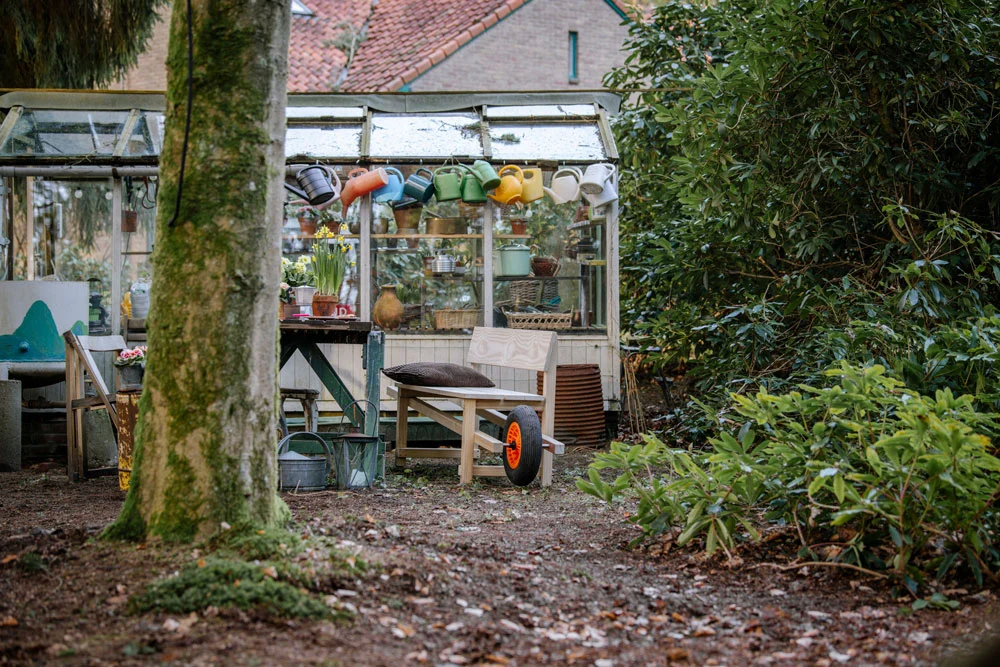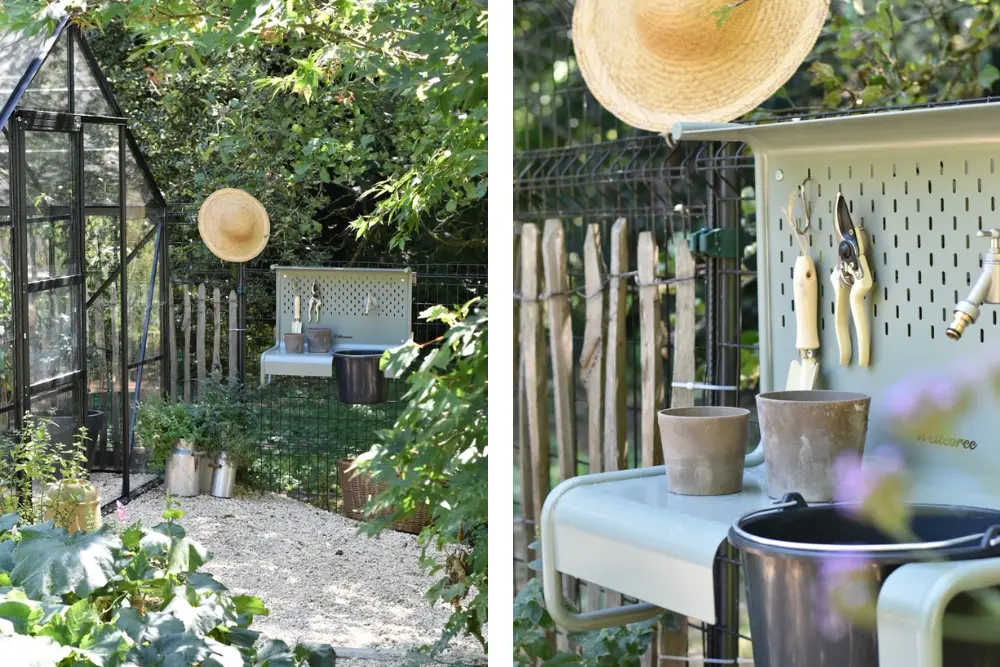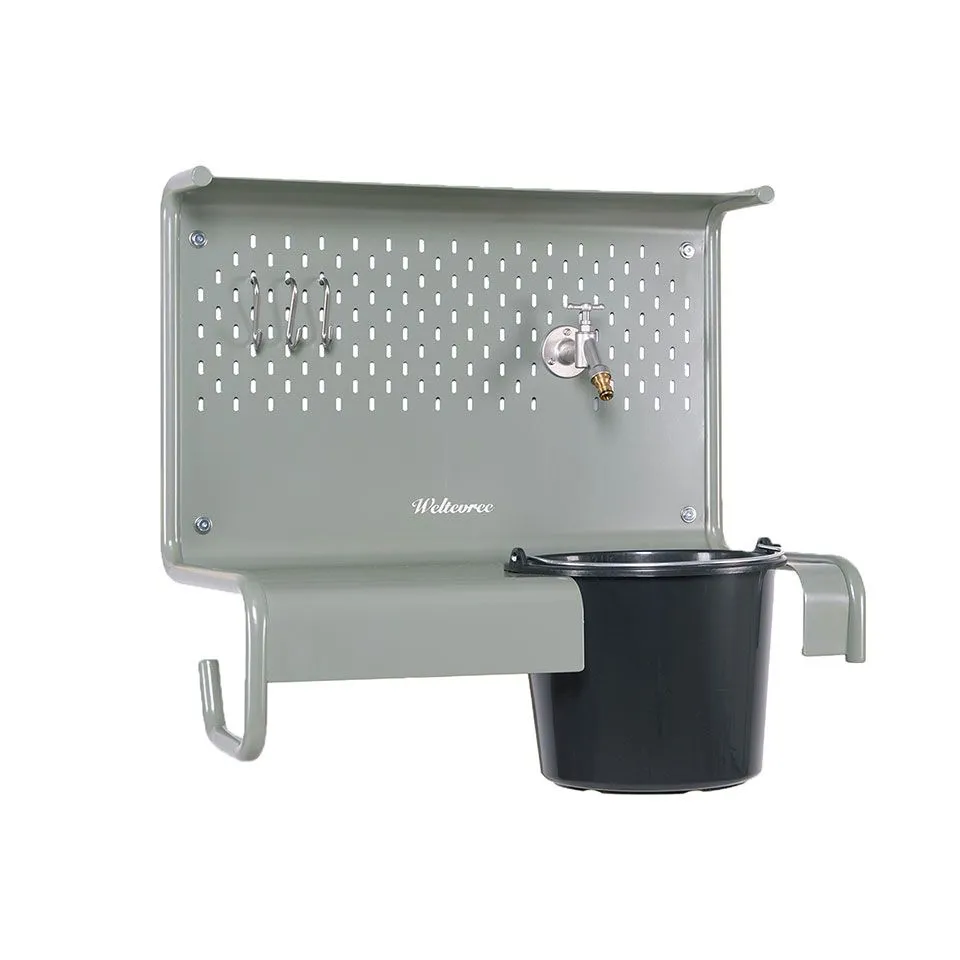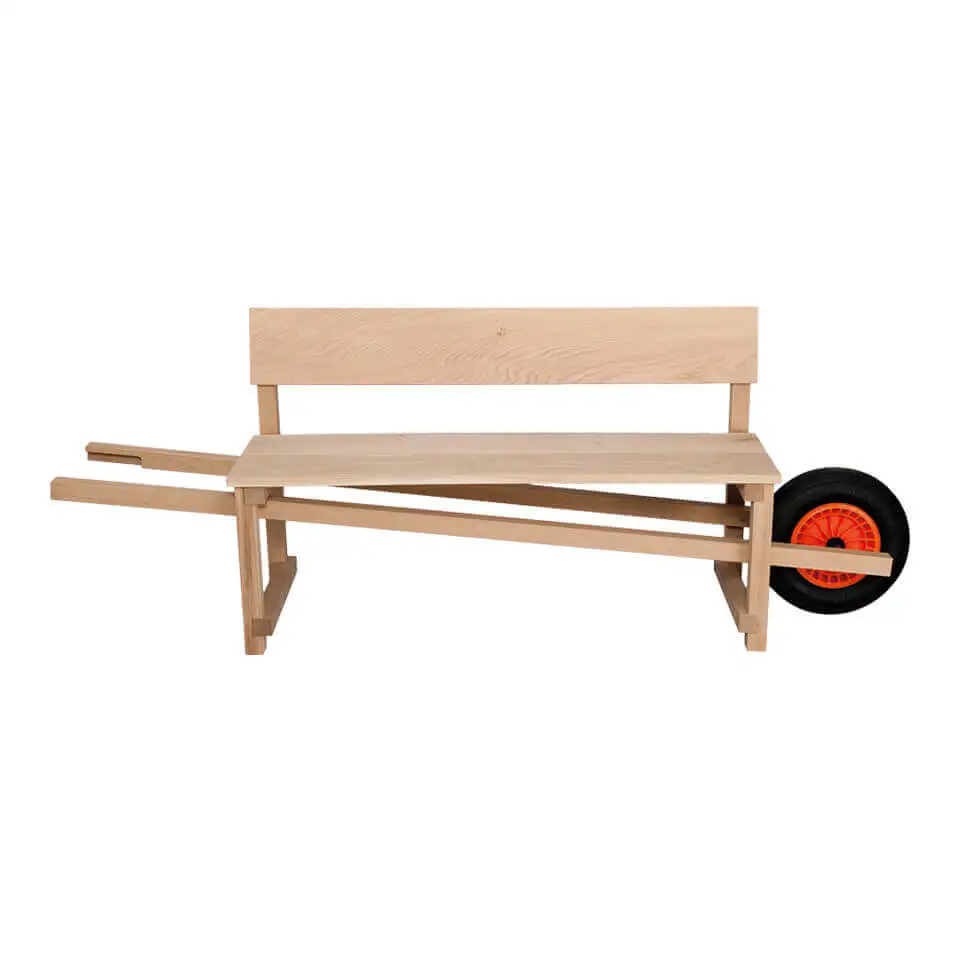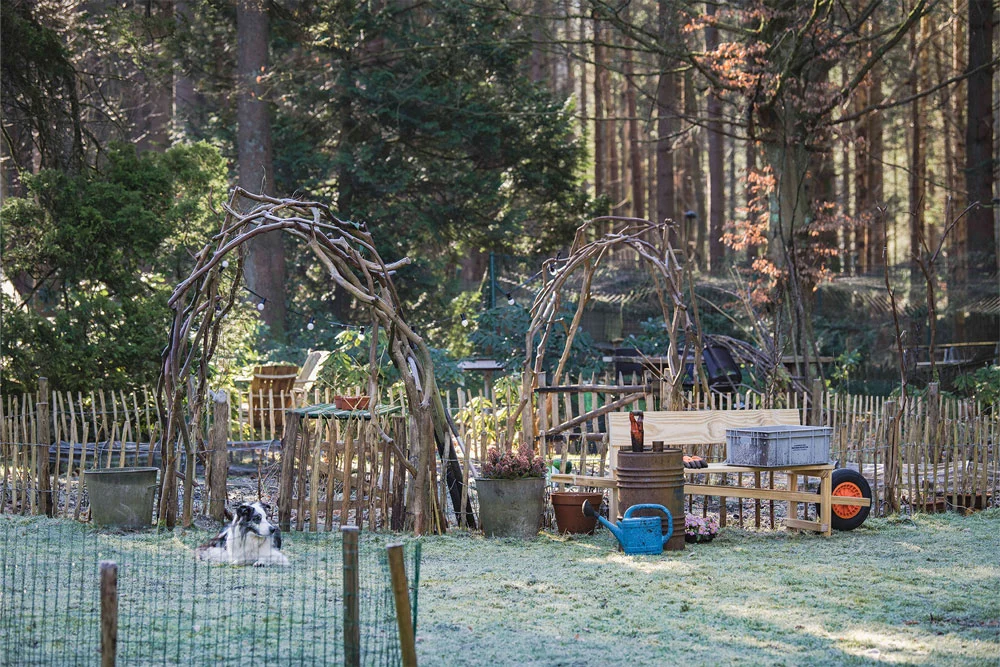
Improve biodiversity in your garden with permaculture
How we can restore nature surprisingly easily - not only on a large scale, but also in your own garden
At Weltevree, we think it's important to look at our environment from a new perspective. We try to achieve this not only with our products, but also with special and meaningful stories. For this story, we delved into the topic of permaculture and interviewed permaculture designer Bor Borren for practical tips that you can immediately apply in your own garden.
Anyone who has their own garden knows how much work it can be - digging, fertilizing, weeding, cutting grass. But it doesn't have to be that way. A garden is actually a miniature ecosystem. And when we leave our gardens alone, they almost automatically become fully self-sustaining ecosystems, where we actually have to do very little ourselves. When you let nature do its thing in your garden, you follow the principles of permaculture. Permaculture is a design method in which you learn to work hand in hand with nature to develop sustainable systems in which the various elements help and strengthen each other. Because when we understand the laws of nature, we can make them work for us, with amazing results.
It is a counter-reaction to today's monoculture, which is actually destructive to nature. Permaculture was conceived in the late 1970s by the Australian Bill Mollison and David Holmgren, with the goal of providing food, energy and shelter to humans in a sustainable way. The researchers predicted even then that the current system of monoculture, where only one crop is grown on a large scale, would eventually only cause problems.
The ecosystem in your garden
Permaculture is essentially about diversity. Something that can be found everywhere in nature, unless you look at the places where humans interfere with nature. In many places things go wrong on a large scale, with entire ecosystems the size of a small country being lost, but even in our own gardens, biodiversity is often nowhere to be found. In the Netherlands we increasingly have to deal with extreme weather conditions: drought, heat, or just extreme downpours, but also summer storms in which sometimes whole areas of forest are razed to the ground. Because of these and more developments, for example, the number of insects in the Netherlands has declined by 75% in the past 30 years. Unintentionally, we often contribute to this ourselves: we place stone terraces so that rainwater cannot soak into the ground and we mow our grass and weed our weeds, reducing soil diversity and depriving insects of a place to nest or find food.
"When you apply the principles of permaculture in your own garden, you restore balance and diversity and your garden naturally becomes maintenance-free."
But: it can be done differently. The goal of permaculture is to restore the balance and diversity of nature in man-made environments. When you apply the principles of permaculture in your own garden, you create a garden that is balanced and self-maintaining, where a variety of plants and trees can thrive optimally and where biodiverse life can be found. In the long run, you'll even have a maintenance-free garden that way.
The tree man
An arid, barren plain. Burning hot sun, a vast drought. That's what the banks of the Brahmaputra River looked like in 1979. Tree-cutting to make room for farmland, extreme heat and an increasingly frequent flooding river caused more and more fertile land to be washed away. What remains is a hot, dry plain where nothing survives. Fast forward to 35 years later and the same area is now a tropical green oasis. Dozens of native plant and tree species make up a jungle that is home to a diversity of insects, birds, as well as Bengal tigers, rhinos and even entire herds of elephants. All thanks to one man, Jadav Payeng, who could not bear to see his homeland lost to the effects of climate change.
It's an incredibly inspiring story: one man who, like some kind of superhero, planted trees every day for years until a new, completely self-sufficient ecosystem formed. And all by simply cooperating with nature, the principle underlying permaculture.
Monoculture: when the solution is the problem
Permaculture was conceived in the 1970s by Australian Bill Mollison and David Holmgren. Even then, they foresaw the problems posed by a system based on economic growth. Our current agricultural and livestock system is based on the principle of monoculture: in order to produce crops as efficiently, cheaply and quickly as possible, the same crop is always grown on the same piece of land. This creates several problems. Because only one crop is grown, not only is the soil depleted, but pests and diseases also have a chance to spread at lightning speed. After all, there is an abundance of food, allowing them to reproduce rapidly. To solve this problem and prevent entire crops from failing at once, pesticides are used. These are detrimental to soil diversity and soil fertility. To re-nourish the soil, fertilizer is used. But fertilizers also cause soil diversity to be lost. This combined with the heavy machinery used to cultivate the land results in the soil becoming completely depleted, soil diversity disappears and the land becomes infertile. There is also the problem of water supply: because only one crop is grown and the soil is nutrient-poor, the water table drops. Irrigation systems use surrounding water reservoirs, such as rivers and lakes. This causes dehydration and erosion of the soil. Last but not least, using all those pesticides and growing only one crop causes bee mortality. It is obvious why this is a problem: worldwide, more than three-quarters of agricultural crops depend on pollinators such as bees.
"It's a vicious cycle, where the natural balance of soil life is disturbed to the point where, in the long run, it leads to agricultural land becoming unusable."
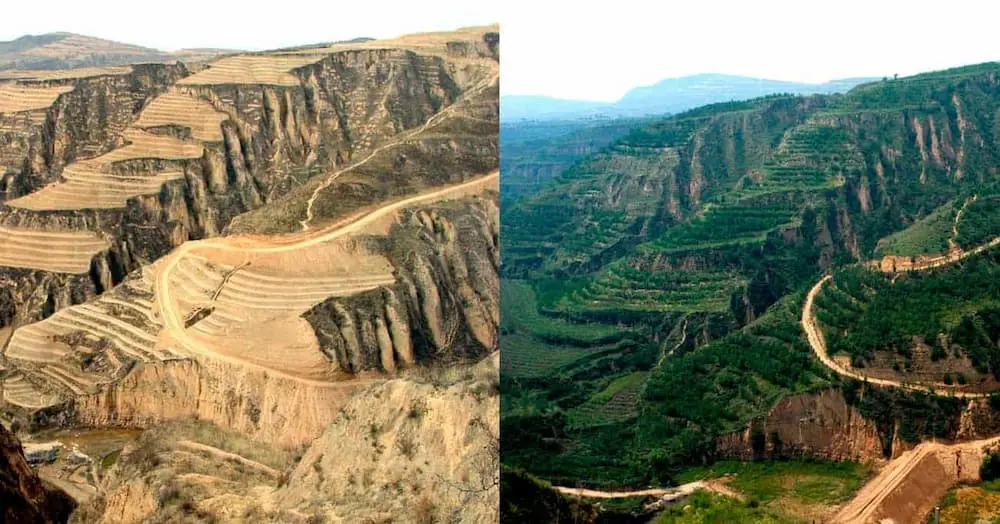
But: there is hope
Long story short: it is a vicious circle, where the natural balance of soil life is disturbed to such an extent that in the long run it leads to the agricultural land becoming unusable. A well-known example of this is the Loess Plateau in China. Due to centuries of overgrazing and exploitation of farmland, almost all vegetation disappeared and a layer of nearly 100 meters of fertile soil was washed away. What remained, as in the area where Jadav Payeng grew up, was a huge dry plain, the size of France, leaving the millions of residents of the area destitute. In the mid-1990s, a program was initiated to restore the fertility and biodiversity of the area. The results have been stunning: within 15 years, more than 35,000 square kilometers of the parched area have been restored. Through the planting of native trees and plants, a restriction on grazing and the installation of irrigation systems, the ecological balance has been restored, a wide variety of crops are grown in the area, and the yield per capita as well as the average salary of each resident of the area has doubled. In addition, the area has become a true carbon sink: an area where more CO2 is stored than emitted. It's such a success story that it's almost too good to be true.
"It's such a success story that it's almost too good to be true."
From big to small
The story of Jadav Payeng and the Loess Plateau have one thing in common: working together with nature restored the natural ecosystem. Both stories point out that our current interaction with nature is wrong. Permaculture bets on changing our attitude toward nature: man not as supreme, but as part of nature. Bor Borren, permaculture designer: "Permaculture is a multidisciplinary design system that focuses on natural systems, in which everything is interconnected and everything has its own function. We cannot change the laws of nature, but when we understand those laws, we can help accelerate the natural processes that benefit everyone. We have forgotten how to nourish the soil and how ecological systems sustain themselves and correct themselves when they become out of balance due to changing conditions. Once that balance is regained, all kinds of things will begin to grow."
"We cannot change the laws of nature, but when we understand those laws, we can help accelerate the natural processes that benefit everyone."
Restoring your own garden
To turn your own garden into a balanced ecosystem, you don't have to be an expert. The best advice, according to Bor, is to just be patient. Restoring balance takes time, so give your garden the time it needs to grow. Start small and focus on something where you can easily make a difference. Even if you have a small garden, you can make a big difference. But restoring your garden according to the principles of permaculture should, above all, be fun. "A garden should be a place where you can have fun. A place where you can create your own paradise. Permaculture is all about letting go of certain beliefs. Beliefs that weeds need to be removed, grass needs to be cut and borders need to be uncovered. Once you let go of these kinds of beliefs, you will soon start asking yourself: why do we design our gardens the way we do?"
1: The wind is your biggest enemy
Bor: "In the Netherlands we are used to flat land, so we also lay out flat gardens. It is a big misconception that we have to level our gardens. Go to a nearby forest and you will never see a flat terrain. In fact, this is a big eye-opener for many people: wind is the biggest enemy in the growth of trees, shrubs and plants. The less resistance a plant faces, the more vigorous its growth will be. A height difference of about half a meter can already create different vegetation. So create the height differences of nature in your garden. Shelter from the wind follows and plants can grow."
2: Weeds are good
Bor: "That we see weeds as something bad that must be removed is one of the biggest misconceptions. Weeds can actually tell you a lot about the condition of your soil. Thistle, for example, an undesirable species, comes up when your soil is fertile but too compact. So that plant is working to give the soil a little more air. Each wild plant has its own function to restore the soil. Over the years, the wild plants that appear will change. When one function ends, another weed with a new function takes over. This continues until the soil is restored and then the weed dominance will decrease." So it's better to choose not to remove weeds. Another strategy is to sow things that will take over the dominance.
3: Get rid of the organic waste bin
Bor: "Don't throw away your garden waste. After all, that also has a function. A tree will drop its weight in leaves multiple times during its life. Purely to feed itself. So we should not rake those leaves away, but keep them within the ecological system of the garden! Nature tends to always cover bare ground with things like wildflowers or weeds. Making sure the soil is covered prevents weeds from growing. Rake things like leaves, wood chips and cut grass toward the edges of your garden and make sure the soil is covered. This not only stops weeds from growing, but also nourishes the soil, creating a balanced soil for plants to grow on. In addition, garbage attracts many insects and birds." With this in mind, it is better to leave dead flowers be in the winter instead of cutting them down, they are an important source of food for birds and insects.
4: Try the no-dig method
Bor: "We don't know any better than that a farmer plows his land, and we do the same in our (vegetable) gardens. But in doing so, you interrupt the soil each time and create a lot of turmoil. And that while soil life is full of helpers that are essential for a healthy garden. The new way to maintain your vegetable garden is the so-called "no-dig method": instead of completely digging up your garden, you cover the soil with a thick layer of compost and then a layer of mulch - organic material such as leaves, wood chips or tree bark that keeps the soil nourished and weeds away. That way, without digging, you can sow or plant in the same soil over and over again. It leads to better soil and a nice bonus is that it's a lot less labor intensive than weeding."
5: Water = life
Bor: "Water is life. For your plants as well as insects and birds. A well-balanced garden should contain some form of water. Water attracts a lot of life and creates a lot of life." Planting is the easiest and most important way to keep water in the garden - in fact, trees, shrubs and plants retain water and thus maintain groundwater levels. Another option for bringing more water into your garden is to disconnect the downspout. Instead of running the rainwater into the sewer system, let it flow directly into the garden. Dig small ditches to your borders or direct the water to a pond. "It always amazes me that once you build a pond, a few weeks later it will be filled with frogs. It has tremendous ecology appeal. So do something with water in your garden. If your garden is small, you may not have room for a pond, but you can also dig a container in the ground and get started with that. Even in small ways you can make a big difference."
6: Lawns and tiled patios are not easy
Bor: "With our gardens, we often think it's easy to build a large lawn and a tiled patio. However, most of the work in the garden comes from those two things. Tiles require a lot of maintenance in the form of removing green stains and weeds between the tiles. And a lawn takes an enormous amount of energy to keep it looking good. Seeding, mowing and watering will keep you busy every week in the summer. Having a green mowed lawn is purely a cultural mentality we are stuck in. Why can't grass grow tall with lots of diversity in it? Try to mow your lawn as little as possible while keeping it comfortable for your situation. Accept the fact that buttercups and dandelions will grow. That's actually a good sign!"

